 |
| Machaerocera mexicana Saussure, 1859 (Mexican Blue-wing Grasshopper) |
 |
| Doris Evans and Lois Manowtz where the Trogon might have been |
Only at the flat, muddy end of the lake a Kingfisher and a Great Egret provided a little activity, and the Trogon flew by after my birding friends had already given up.
The further I followed the trail (maybe just a cattle path) away from the lake into the riparian forest of Willows, Cottonwoods and Walnut Trees, the more butterflies, dragonflies, wasps and grasshoppers I encountered.
Mounds of decaying debris left over from many floods provide rich soil for many leafy plants under the shady canopy of the gallery trees. Cattle had added nutrients and churned it over - were doing so as I watched.
I found tobacco plants as tall as myself and with huge leaves that could have wrapped cigars for giants. And from the knee-high level of tobacco and seep willow I scared up dozens of sizable grasshoppers with deep-blue underwings.
 |
| The hind wings that only flash during flight (Photo Bob Beatson, Las Cienegas) |
The grasshoppers occurred in solid numbers and in behavior (sitting knee-high in leafy plants, flying up nearly as a group) and wing color so distinctly different from other species that I'm surprised that they were so rarely observed.
They are probably very seasonal (like most GHs), don't occur in places other than the limited habitat of a specific riparian forest, and maybe I just hit one of their boom years. But of course, I personally don't often feel like paying the steep price of $15 to get access to Patagonia Lake State Park. It seems that this location is quite close to the first US record in 1972.
Litrature: First records of grasshopper Machaerocera mexicanaSaussure, 1859 (Orthoptera: Acrididae)from the United States and Sonora, Mexico. R.A.Behrstock, P.H.Sullivan. Insecta Mundi 11-2-2011












That is wonderful news. I'm sure we will be seeing more Mexican species in Arizona and New Mexico as the years go by. We're already seeing Arizona dragonflies here in Colorado!
ReplyDelete